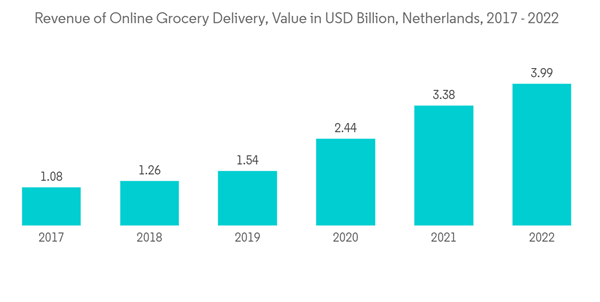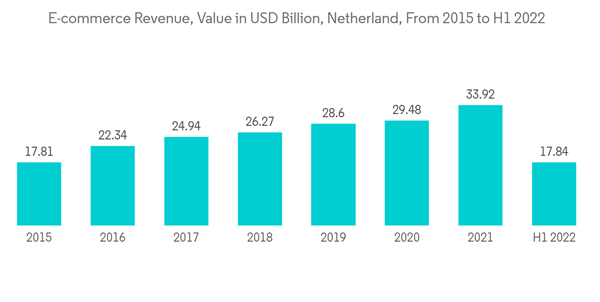The Netherlands Last Mile Delivery Market size is estimated at USD 6.33 billion in 2024, and is expected to reach USD 8.09 billion by 2029, growing at a CAGR of 5% during the forecast period (2024-2029).
Last-mile delivery in the Netherlands has progressed to the next level, demonstrating to the rest of the world that goods can be carried to varied areas with ease without the use of large trucks. In addition, sustainability is emerging as a major factor across all industries. To maintain a low carbon footprint, most service providers are employing smaller vehicles, such as electric cargo bikes, unmanned electric vehicles, etc. For instance, in 2021, DPD Netherlands completed a five-day trial of the latest unmanned autonomous delivery vehicle from Estonian innovator Cleveron
The COVID-19 pandemic caused worldwide lockdowns, disrupted commercial activities, and challenged the economy but created widespread opportunities for the last-mile delivery market. In addition, the pandemic resulted in a consumer shift, causing a surge in e-commerce retail sales. This further fueled the powerful opportunity for logistics industrialists to push through real and lasting change. Since the coronavirus outbreak, the volume of online orders and frequency of orders from Dutch families has increased dramatically.
Meanwhile, in 2022, the Netherlands saw unprecedented growth in last-mile delivery; the growing e-commerce sales and online grocery sales are the major drivers of last-mile delivery services in the country. Moreover, the country designed last-mile city hubs to increase route efficiency. This concept aimed at reducing the number of kilometers driven (i.e., the number of vehicles in cities) by better bundling parcels outside of city centers. Utilization of these city centers further ensures 100% emission-free last-mile delivery. Thus, the country is focusing on innovation in the market to meet the growing demand from end users.
Moreover, online grocery sales are witnessing significant growth in the Netherlands; according to industry experts, the country stands next to the United Kingdom and France in the European countries, where most of the consumers are willing to shop for online groceries from the advanced markets.
Meanwhile, to meet the growing demand from consumers, most of the players in the market are planning expansions. For instance, in September 2021, Picnic, an online grocery service based in the Netherlands, raised more than USD 706 million in funding to expedite its expansion strategies. Moreover, as per industry sources, in 2022, the Netherlands generated more than USD 6.7 billion in the online food sales market, from which more than 60% is contributed from online grocery sales. Thus, the growing online food sales require a huge last-mile delivery network support to meet consumer expectations, further driving the last-mile delivery market in the country.
Meanwhile, in the first half of 2022, consumers in the Netherlands spent more than USD 17 billion on e-commerce sales, which was up by nearly 9% when compared to the same period a year earlier. A rise in online sales of services mostly supported the growth. Moreover, in H1 2022, in total, Dutch consumers made 168 million purchases online.
On the other hand, the country’s retail sector also witnessed a significant number of sales; in February 2023, online retail turnover increased by more than 6% when compared to the same periods of the previous year. In addition, web shops recorded a turnover increase of 11%, and their core activity is selling goods and services over the Internet. Meanwhile, e-commerce sales majorly depend on delivery price and speed. Thus, the growing e-commerce sales will drive the demand for last-mile service providers in the country.
This product will be delivered within 2 business days.
Last-mile delivery in the Netherlands has progressed to the next level, demonstrating to the rest of the world that goods can be carried to varied areas with ease without the use of large trucks. In addition, sustainability is emerging as a major factor across all industries. To maintain a low carbon footprint, most service providers are employing smaller vehicles, such as electric cargo bikes, unmanned electric vehicles, etc. For instance, in 2021, DPD Netherlands completed a five-day trial of the latest unmanned autonomous delivery vehicle from Estonian innovator Cleveron
The COVID-19 pandemic caused worldwide lockdowns, disrupted commercial activities, and challenged the economy but created widespread opportunities for the last-mile delivery market. In addition, the pandemic resulted in a consumer shift, causing a surge in e-commerce retail sales. This further fueled the powerful opportunity for logistics industrialists to push through real and lasting change. Since the coronavirus outbreak, the volume of online orders and frequency of orders from Dutch families has increased dramatically.
Meanwhile, in 2022, the Netherlands saw unprecedented growth in last-mile delivery; the growing e-commerce sales and online grocery sales are the major drivers of last-mile delivery services in the country. Moreover, the country designed last-mile city hubs to increase route efficiency. This concept aimed at reducing the number of kilometers driven (i.e., the number of vehicles in cities) by better bundling parcels outside of city centers. Utilization of these city centers further ensures 100% emission-free last-mile delivery. Thus, the country is focusing on innovation in the market to meet the growing demand from end users.
Netherlands Last Mile Delivery Market Trends
Increase in Online Grocery Sales Driving the Market Growth
The Netherlands is home to plenty of grocery delivery services, and Albert Heijn, Jumbo, PLUS, Coop, etc., are some of the major online grocery shopping sites in the country. In addition, the pandemic fostered the demand for online grocery channels, which was majorly driven by changes in consumer behavior. Also, this shift further resulted in record growth of the competitive landscape as new players flooded the market, often backed by large investors.Moreover, online grocery sales are witnessing significant growth in the Netherlands; according to industry experts, the country stands next to the United Kingdom and France in the European countries, where most of the consumers are willing to shop for online groceries from the advanced markets.
Meanwhile, to meet the growing demand from consumers, most of the players in the market are planning expansions. For instance, in September 2021, Picnic, an online grocery service based in the Netherlands, raised more than USD 706 million in funding to expedite its expansion strategies. Moreover, as per industry sources, in 2022, the Netherlands generated more than USD 6.7 billion in the online food sales market, from which more than 60% is contributed from online grocery sales. Thus, the growing online food sales require a huge last-mile delivery network support to meet consumer expectations, further driving the last-mile delivery market in the country.
Developing E-commerce Industry Fueling the Demand for Last Mile Logistics
The Netherlands witnessing significant growth in e-commerce sales, which was majorly driven by the pandemic-affected consumer shift. In 2021, as per the Dutch National Ecommerce Association study online spending was stronger when compared to the previous year. In 2021, the pandemic triggered online sales to experience a growth rate of more than 15% when compared to 2020.Meanwhile, in the first half of 2022, consumers in the Netherlands spent more than USD 17 billion on e-commerce sales, which was up by nearly 9% when compared to the same period a year earlier. A rise in online sales of services mostly supported the growth. Moreover, in H1 2022, in total, Dutch consumers made 168 million purchases online.
On the other hand, the country’s retail sector also witnessed a significant number of sales; in February 2023, online retail turnover increased by more than 6% when compared to the same periods of the previous year. In addition, web shops recorded a turnover increase of 11%, and their core activity is selling goods and services over the Internet. Meanwhile, e-commerce sales majorly depend on delivery price and speed. Thus, the growing e-commerce sales will drive the demand for last-mile service providers in the country.
Netherlands Last Mile Delivery Industry Overview
The last mile delivery market of the Netherlands is fragmented in nature, with a mix of global and local players, which makes the sector highly competitive. Some of the strong players in the country include PostNL, DHL, Geodis, DPD, and UPS. The pandemic has improved the industry as there were lockdown restrictions imposed across the country.Additional Benefits:
- The market estimate (ME) sheet in Excel format
- 3 months of analyst support
This product will be delivered within 2 business days.
Table of Contents
1 INTRODUCTION
2 RESEARCH METHODOLOGY
4 MARKET INSIGHTS AND DYNAMICS
5 MARKET SEGMENTATION
6 COMPETITIVE LANDSCAPE
Methodology

LOADING...










